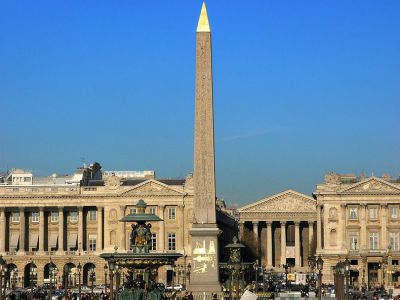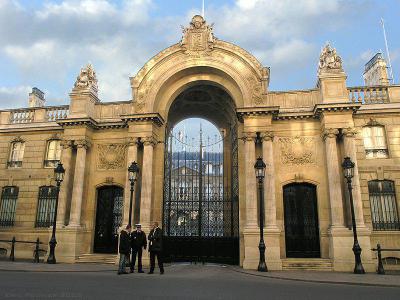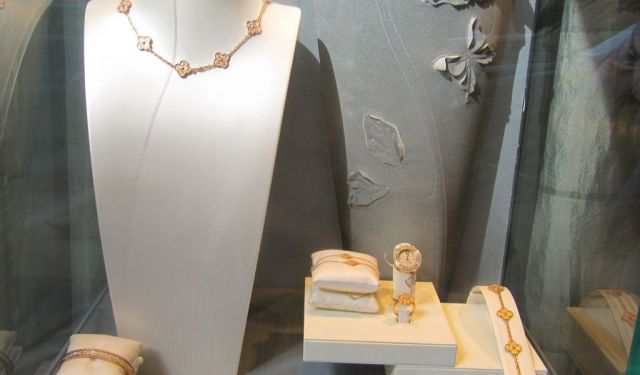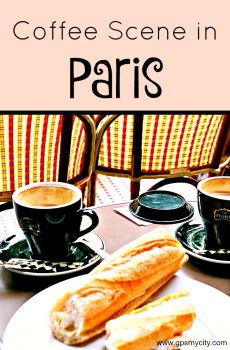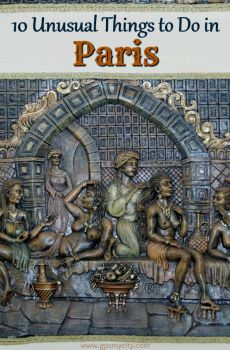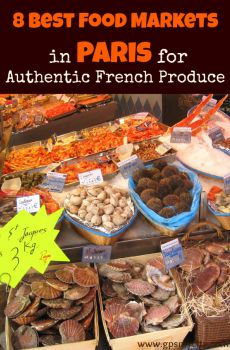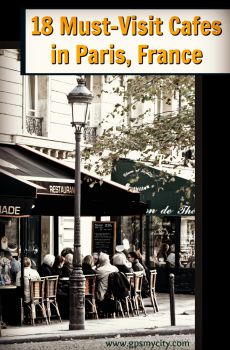
Champs-Elysees Walking Tour (Self Guided), Paris
On this self-guided walk you will witness the grandeur of the 8th arrondissement of the French capital – one of its busiest and chic neighborhoods, thanks to the presence of Avenue des Champs-Elysées, Arc de Triomphe, and Place de la Concorde.
Your best plan would be to start with the Triumphal Arch and walk up to its viewing area for great sights down the Champs-Élysées – a lovely green space with ornate fountains, where you can have a typical Parisian picnic lunch. Then there is the Grand Palais – a magnificent Beaux-Arts structure both inside and out, playing host to many fantastic shows and exhibitions throughout the year. Ending the first stretch, Place de la Concorde is home of the Petit Palais and the Obelisk – one of a pair from Luxor in Egypt!
These alone make it an excellent neighborhood to visit, but you can also take a turn to visit the Madeleine, which, from the outside, looks like an old Roman temple and the interior is just stunning with elaborate artworks everywhere. The Élysée Palace is great for an outside view since it’s only open once a year, but more exquisite interiors can be seen in either the Jacquemart-André Museum or the Nissim de Camondo House-Museum located nearby.
Take this self-guided tour to visit the bull’s-eye center of Paris and to take in some of the most prominent sights in the grand metropolis!
Your best plan would be to start with the Triumphal Arch and walk up to its viewing area for great sights down the Champs-Élysées – a lovely green space with ornate fountains, where you can have a typical Parisian picnic lunch. Then there is the Grand Palais – a magnificent Beaux-Arts structure both inside and out, playing host to many fantastic shows and exhibitions throughout the year. Ending the first stretch, Place de la Concorde is home of the Petit Palais and the Obelisk – one of a pair from Luxor in Egypt!
These alone make it an excellent neighborhood to visit, but you can also take a turn to visit the Madeleine, which, from the outside, looks like an old Roman temple and the interior is just stunning with elaborate artworks everywhere. The Élysée Palace is great for an outside view since it’s only open once a year, but more exquisite interiors can be seen in either the Jacquemart-André Museum or the Nissim de Camondo House-Museum located nearby.
Take this self-guided tour to visit the bull’s-eye center of Paris and to take in some of the most prominent sights in the grand metropolis!
How it works: Download the app "GPSmyCity: Walks in 1K+ Cities" from Apple App Store or Google Play Store to your mobile phone or tablet. The app turns your mobile device into a personal tour guide and its built-in GPS navigation functions guide you from one tour stop to next. The app works offline, so no data plan is needed when traveling abroad.
Champs-Elysees Walking Tour Map
Guide Name: Champs-Elysees Walking Tour
Guide Location: France » Paris (See other walking tours in Paris)
Guide Type: Self-guided Walking Tour (Sightseeing)
# of Attractions: 8
Tour Duration: 2 Hour(s)
Travel Distance: 4.7 Km or 2.9 Miles
Author: karen
Sight(s) Featured in This Guide:
Guide Location: France » Paris (See other walking tours in Paris)
Guide Type: Self-guided Walking Tour (Sightseeing)
# of Attractions: 8
Tour Duration: 2 Hour(s)
Travel Distance: 4.7 Km or 2.9 Miles
Author: karen
Sight(s) Featured in This Guide:
- Arc de Triomphe (Triumphal Arch)
- Avenue des Champs-Elysees (Champs-Elysees Avenue)
- Grand Palais (Grand Palace)
- Place de la Concorde (Concorde Square)
- La Madeleine (Church of St Mary Magdalene)
- Palais de l'Elysee (Elysee Palace)
- Musee Jacquemart-Andre (Jacquemart-Andre Museum)
- Musee Nissim de Camondo (Decorative Arts - House Museum)
1) Arc de Triomphe (Triumphal Arch) (must see)
The spot at the termination of the Champs Elysées Avenue was always the subject of numerous plans for some kind of landmark monument. It was not until 1806, however, that Emperor Napoleon finally decreed that a triumphal arch, dedicated to the glory of his Great Army, should be built on the site. Napoleon's architectural projects all made clear his desire to identify his regime with the glory of imperial Rome, and the design was inspired by the Roman Arch of Titus.
The measure of Napoleon's audacious ambitions can be seen from the size of the Arc de Triomphe: a colossal 45 meters wide by 50 meters high, making it almost certainly the biggest triumphal arch in the world. Because of the presence today of the towers of La Défense on Paris's western horizon, it is hard to appreciate the Arc's original impact on the cityscape, when it was the most prominent and massive object for miles around, a hegemony it retained until the building of the Eiffel Tower in the 1880s.
Inevitably, the arch quickly became an object of the national pride and subsequently the world-famous symbol of French patriotism. Built in the era when a war was undoubtedly the "overriding argument of kings", the arch was intended primarily for triumphal entrances into Paris by victorious French troops. Napoleon himself had a chance to pass beneath this arch mock-up replica only once, together with his bride Marie-Louise, the Archduchess of Austria, in 1810. The other Napoleon – Napoleon III – was more fortunate in this respect, and was able to ride underneath the completed arch upon his ascending to the throne in 1852.
As to the proper victory march, the Triumphal Arch saw it for the first time only in 1919. The aftermath of World War I, though, shifted the French public interest away from war and, as of 1921, the arch has been solely the place of commemoration of the fallen soldiers, for which purpose there's a tomb of the Unknown Soldier and the Flame of Remembrance.
Tip:
The roundabout encircling the Arc de Triomphe is referred to by Parisians as L'Étoile, or "the Star," due to the 12 avenues that emanate from it. By climbing the stairs to the top of the arch, you can witness the star-shaped pattern of the radiating streets and enjoy a panoramic view of the Champs-Élysées leading towards Place de la Concorde and the Musée du Louvre in the distance.
The measure of Napoleon's audacious ambitions can be seen from the size of the Arc de Triomphe: a colossal 45 meters wide by 50 meters high, making it almost certainly the biggest triumphal arch in the world. Because of the presence today of the towers of La Défense on Paris's western horizon, it is hard to appreciate the Arc's original impact on the cityscape, when it was the most prominent and massive object for miles around, a hegemony it retained until the building of the Eiffel Tower in the 1880s.
Inevitably, the arch quickly became an object of the national pride and subsequently the world-famous symbol of French patriotism. Built in the era when a war was undoubtedly the "overriding argument of kings", the arch was intended primarily for triumphal entrances into Paris by victorious French troops. Napoleon himself had a chance to pass beneath this arch mock-up replica only once, together with his bride Marie-Louise, the Archduchess of Austria, in 1810. The other Napoleon – Napoleon III – was more fortunate in this respect, and was able to ride underneath the completed arch upon his ascending to the throne in 1852.
As to the proper victory march, the Triumphal Arch saw it for the first time only in 1919. The aftermath of World War I, though, shifted the French public interest away from war and, as of 1921, the arch has been solely the place of commemoration of the fallen soldiers, for which purpose there's a tomb of the Unknown Soldier and the Flame of Remembrance.
Tip:
The roundabout encircling the Arc de Triomphe is referred to by Parisians as L'Étoile, or "the Star," due to the 12 avenues that emanate from it. By climbing the stairs to the top of the arch, you can witness the star-shaped pattern of the radiating streets and enjoy a panoramic view of the Champs-Élysées leading towards Place de la Concorde and the Musée du Louvre in the distance.
2) Avenue des Champs-Elysees (Champs-Elysees Avenue) (must see)
By far the most popular avenue of France, Champs-Élysées is a household name deeply rooted in the Greek mythology as a resting place for the blessed souls. Stretching for about 2 km, this major Paris thoroughfare extends from Place de la Concorde to Place Charles de Gaulle, boasting, apart from the exuberant shopping, luxurious dining and world-class entertainment and some of the top photographic panoramas of the French capital – particularly that opening from the top of the Arch of Triumph.
At one end, Champs-Élysées is straddled by a patch of greenery, surrounded by landmark attractions such as the Grand Palace and the Small Palace, housing a bunch of art galleries. Once a year, on the Bastille Day, the avenue hosts a military parade, as well as sees the finish of the annual Tour de France cycling race.
As a staple destination for foodies, it offers a choice of gourmet eateries fit to spoil even the most discerning gluttons. Among the places particularly worth checking out here are: bistro Atelier Renault; Flora Danica – renowned for its caviar; Fouquet's restaurant aged over 100 years; the famous Ladurée tea room; as well as L'Alsace Bistro specializing, just as the name suggests, in the cuisine from the Alsace region of France, open 24 hours a day.
Those craving entertainment will find it here in equally rich supply. Cinema Gaumont, France's #1 screen for movie premiers; the world famous cabaret Lido; the bar and club Montecristo; Le Queen nightclub with some of the top DJs in town, plus the Marigny Theatre are just some of the options to consider.
Why You Should Visit:
Whatever the season, day or night, Champs-Élysées never fails to impress.
Still, if you come here around Christmas, you'll be in for a special treat!
At one end, Champs-Élysées is straddled by a patch of greenery, surrounded by landmark attractions such as the Grand Palace and the Small Palace, housing a bunch of art galleries. Once a year, on the Bastille Day, the avenue hosts a military parade, as well as sees the finish of the annual Tour de France cycling race.
As a staple destination for foodies, it offers a choice of gourmet eateries fit to spoil even the most discerning gluttons. Among the places particularly worth checking out here are: bistro Atelier Renault; Flora Danica – renowned for its caviar; Fouquet's restaurant aged over 100 years; the famous Ladurée tea room; as well as L'Alsace Bistro specializing, just as the name suggests, in the cuisine from the Alsace region of France, open 24 hours a day.
Those craving entertainment will find it here in equally rich supply. Cinema Gaumont, France's #1 screen for movie premiers; the world famous cabaret Lido; the bar and club Montecristo; Le Queen nightclub with some of the top DJs in town, plus the Marigny Theatre are just some of the options to consider.
Why You Should Visit:
Whatever the season, day or night, Champs-Élysées never fails to impress.
Still, if you come here around Christmas, you'll be in for a special treat!
3) Grand Palais (Grand Palace)
The Grand Palace and its sister, the Small Palace, just across the street, were conceived simultaneously as centerpieces for the 1900 World Fair in Paris. In that, the former palace was to accommodate fine arts, comprising various "salons" showcasing the artistic life of the French capital. Masterminded by four different architects, the palace took the form of an enormous glass-iron pavilion quite suitable for exhibiting sculpture and paintings. Curiously enough, the facility also suits for and, in fact, regularly hosts... horse shows!
Its façade is a typical example of Beaux-Arts architecture and is dominated by an enormous 8-tonne Art Nouveau glass roof, the largest in Europe. Reportedly, its construction took more steel than the entire Eiffel Tower. When the night falls and the lights go up, the play of light on the pillars, columns, scrolls and roof glazing produces a magical sight that leaves no one indifferent.
Inside, there are three major sections, namely: the Main Hall, the National Galleries, and the Palace of Discovery, which is the museum and cultural center dedicated to science. The Main Hall is undeniably festive and, although heavily criticized by its contemporaries initially, it is now widely admired. Quite spacious, the Main Hall is usually partially closed and gets fully open for special events only.
But the museum and the exhibition section are open all the time and are very well laid out and interesting on their own. There are several exhibitions and art fairs underway there perpetually, each of which has its own separate entrance. Also, on the premises, there is a cinema theater, a restaurant and, seasonally, even a skate rink.
Tip:
Should you decide to visit, don't miss the Petit Palais just across the street while you're there!
Its façade is a typical example of Beaux-Arts architecture and is dominated by an enormous 8-tonne Art Nouveau glass roof, the largest in Europe. Reportedly, its construction took more steel than the entire Eiffel Tower. When the night falls and the lights go up, the play of light on the pillars, columns, scrolls and roof glazing produces a magical sight that leaves no one indifferent.
Inside, there are three major sections, namely: the Main Hall, the National Galleries, and the Palace of Discovery, which is the museum and cultural center dedicated to science. The Main Hall is undeniably festive and, although heavily criticized by its contemporaries initially, it is now widely admired. Quite spacious, the Main Hall is usually partially closed and gets fully open for special events only.
But the museum and the exhibition section are open all the time and are very well laid out and interesting on their own. There are several exhibitions and art fairs underway there perpetually, each of which has its own separate entrance. Also, on the premises, there is a cinema theater, a restaurant and, seasonally, even a skate rink.
Tip:
Should you decide to visit, don't miss the Petit Palais just across the street while you're there!
4) Place de la Concorde (Concorde Square)
Place de la Concorde is the largest and the most monumental of all Parisian squares, best known for its 230-ton Egyptian obelisk, aged over 3,000 years, which makes it by far the most ancient monument in Paris. The obelisk is flanked on the sides with two magnificent fountains – the "Maritime Fountain" and the "Fountain of the Rivers" – built in 1836 and recently restored to their original exuberance. Respectively, they symbolize French seagoing spirit and passion for inland navigation. In continuation of the nautical theme, there are 20 rostral columns throughout the square adorned with a ship prow which is part of the official Paris emblem.
Designed initially to glorify the absolute power of monarchs, at some point the square became the theater of its downfall. The equestrian statue of King Louis XVI, that once stood in its center, was torn down during the French Revolution, upon which the square was renamed "Place de la Révolution." Instead of the monument, the new revolutionary government installed there a guillotine, the first "client" of which became none other than the King himself. Among other notables who shared his fate there later on, in front of the cheering crowd, were Queen Marie Antoinette, Princess Élisabeth of France, and Maximilien Robespierre.
The guillotine remained quite busy throughout the "Reign of Terror" in the summer of 1794, when in a single month more than 1,300 people were executed. A year later, when the revolution took a more moderate course, it was removed.
Today, major avenues converge and pass through Place de la Concorde so vehicle traffic can always be expected; however, the roundabout with the three important monuments – obelisk and fountains – is well worth viewing. The square is sometimes used for large scale events and festivals like Christmas markets and other festival activities.
Concorde Square is a popular tourist spot, ideal for photos; conveniently located to fan out from to just about any major attraction in Paris. All the main avenues of the French capital either converge at or pass through it, making it a somewhat traffic-dense roundabout at times. The square regularly hosts public events, Christmas fairs, and festivals.
Tip:
In the square, there is a big Ferris wheel for those keen on getting a bird's eye view over the nearby river Seine, Louvre, Tuileries Garden, Champs-Élysées, Triumphal Arch, and the Eiffel Tower. This wheel turns three times faster than the London Eye, actually, and is much cheaper too!
Designed initially to glorify the absolute power of monarchs, at some point the square became the theater of its downfall. The equestrian statue of King Louis XVI, that once stood in its center, was torn down during the French Revolution, upon which the square was renamed "Place de la Révolution." Instead of the monument, the new revolutionary government installed there a guillotine, the first "client" of which became none other than the King himself. Among other notables who shared his fate there later on, in front of the cheering crowd, were Queen Marie Antoinette, Princess Élisabeth of France, and Maximilien Robespierre.
The guillotine remained quite busy throughout the "Reign of Terror" in the summer of 1794, when in a single month more than 1,300 people were executed. A year later, when the revolution took a more moderate course, it was removed.
Today, major avenues converge and pass through Place de la Concorde so vehicle traffic can always be expected; however, the roundabout with the three important monuments – obelisk and fountains – is well worth viewing. The square is sometimes used for large scale events and festivals like Christmas markets and other festival activities.
Concorde Square is a popular tourist spot, ideal for photos; conveniently located to fan out from to just about any major attraction in Paris. All the main avenues of the French capital either converge at or pass through it, making it a somewhat traffic-dense roundabout at times. The square regularly hosts public events, Christmas fairs, and festivals.
Tip:
In the square, there is a big Ferris wheel for those keen on getting a bird's eye view over the nearby river Seine, Louvre, Tuileries Garden, Champs-Élysées, Triumphal Arch, and the Eiffel Tower. This wheel turns three times faster than the London Eye, actually, and is much cheaper too!
5) La Madeleine (Church of St Mary Magdalene)
La Madeleine is a Roman Catholic church named after Mary Magdalene and inspired by ancient Roman temples, sitting nobly in the centre of Haussmannian Paris. Leading to it is the smart and elegant Galerie de la Madeleine – a passage constructed in the 1840s that is impeccably preserved and now home to opulent boutiques and charming cafés.
La Madeleine's construction, started during the reign of King Louis XV, suffered several stoppages including a major one during the French Revolution. Eventually, in 1806, Napoleon announced the decision to make it a temple to glorify his Great Army and commissioned to the job the architect Pierre Vignon. Evidently aware of the emperor's taste for opulent imperial Roman-style architecture, Vignon came up with the idea of an enormous Corinthian temple. He was still working on the project when Napoleon was demoted. The replacing him King Louis XVIII kept Vignon on, but ordered that the temple be made into a church.
The most striking feature of La Madeleine is its enormous size, in part prompted by the surrounding monumentality of Place de la Concorde, but also, no doubt, due to the inflated ego of Napoleon Bonaparte himself. Devoid of windows, so as not to disturb the severity of the temple, the light is let in from above, via three domes open at the top, in the manner of the Roman Pantheon. Each dome is supported by four Corinthian arches with pendentives, featuring a grand imperial Roman style.
Tip:
In the basement of the church is the Foyer de la Madeleine which today plays host to some of the most fashionable concerts and wedding parties in Paris. The concerts take place several times a month on Sunday afternoon and include baroque and chamber music, as well as organ recitals and symphonic orchestral performances.
La Madeleine's construction, started during the reign of King Louis XV, suffered several stoppages including a major one during the French Revolution. Eventually, in 1806, Napoleon announced the decision to make it a temple to glorify his Great Army and commissioned to the job the architect Pierre Vignon. Evidently aware of the emperor's taste for opulent imperial Roman-style architecture, Vignon came up with the idea of an enormous Corinthian temple. He was still working on the project when Napoleon was demoted. The replacing him King Louis XVIII kept Vignon on, but ordered that the temple be made into a church.
The most striking feature of La Madeleine is its enormous size, in part prompted by the surrounding monumentality of Place de la Concorde, but also, no doubt, due to the inflated ego of Napoleon Bonaparte himself. Devoid of windows, so as not to disturb the severity of the temple, the light is let in from above, via three domes open at the top, in the manner of the Roman Pantheon. Each dome is supported by four Corinthian arches with pendentives, featuring a grand imperial Roman style.
Tip:
In the basement of the church is the Foyer de la Madeleine which today plays host to some of the most fashionable concerts and wedding parties in Paris. The concerts take place several times a month on Sunday afternoon and include baroque and chamber music, as well as organ recitals and symphonic orchestral performances.
6) Palais de l'Elysee (Elysee Palace)
The Élysée Palace is a truly emblematic property of the French capital, located just a few steps away from the Madeleine church, not far from Champs Elysées. Constructed in the early 18th century and initially owned by the Count of Evreux, it can be found on Rue Saint-Honoré, one of the most prominent streets of Paris.
Lavishly enlarged and repainted during the Second Empire in the fashionable style of that period, the palace has retained much of its original appearance dating back to the days of its first owner. The distinguishable, vast grounds allowed the architect Armand-Claude Mollet to give it something of an air of a small castle. Later, one of the most influential French architectural theorists Jacques-François Blondel described the palace as having the "air of magnificence" and being "the most beautiful mansion in the Paris region".
Having changed hands several times, the palace finally became residence of a French President in 1873. The actual office of the head of state, the Gold Room, has changed very little since. The terrestrial globe, a significant element of the interior, was brought in by Charles de Gaulle. Today, the French Government holds regular meetings at the palace.
In the underground section, there is a room with the red button pushing which the President of France can activate the country's nuclear arsenal. The room is also fitted with large screens and communication module linking the President directly to the Minister of Defense and strategic air force commander.
It so happens that presently, with the exception of the European Heritage Days, it is almost impossible for ordinary people to get into the palace. Still, it is well worth the while to view it from the outside. So, whenever you're in Paris, just make sure to walk by.
Lavishly enlarged and repainted during the Second Empire in the fashionable style of that period, the palace has retained much of its original appearance dating back to the days of its first owner. The distinguishable, vast grounds allowed the architect Armand-Claude Mollet to give it something of an air of a small castle. Later, one of the most influential French architectural theorists Jacques-François Blondel described the palace as having the "air of magnificence" and being "the most beautiful mansion in the Paris region".
Having changed hands several times, the palace finally became residence of a French President in 1873. The actual office of the head of state, the Gold Room, has changed very little since. The terrestrial globe, a significant element of the interior, was brought in by Charles de Gaulle. Today, the French Government holds regular meetings at the palace.
In the underground section, there is a room with the red button pushing which the President of France can activate the country's nuclear arsenal. The room is also fitted with large screens and communication module linking the President directly to the Minister of Defense and strategic air force commander.
It so happens that presently, with the exception of the European Heritage Days, it is almost impossible for ordinary people to get into the palace. Still, it is well worth the while to view it from the outside. So, whenever you're in Paris, just make sure to walk by.
7) Musee Jacquemart-Andre (Jacquemart-Andre Museum)
As you step inside, you can almost transport yourself to the grand parties that once took place in this Parisian mansion. Once the home of art collectors Nélie Jacquemart and Édouard André, this opulent residence from the late 19th century seamlessly blends elements from different eras, with Greek and Roman antiquities, Egyptian artifacts, period furnishings, and portraits by Dutch masters on display. Its 16 rooms provide a captivating peek into the lifestyle of Parisian high society, from the library adorned with canvases by Rembrandt and Van Dyck to the stunning Jardin d'Hiver, a glass-paned garden room featuring a magnificent double-helix staircase.
In other words, a mansion that not only showcases remarkable art collections but also reflects the lifestyle of the 19th-century Parisian bourgeoisie.
Why You Should Visit:
This rare glimpse into the lavish life of a wealthy couple is full of surprises and offers the chance to enjoy tea beneath the ceiling decorations by Giovanni Battista Tiepolo. Other masterpieces on display include works by Botticelli, Boucher, and Rembrandt.
In other words, a mansion that not only showcases remarkable art collections but also reflects the lifestyle of the 19th-century Parisian bourgeoisie.
Why You Should Visit:
This rare glimpse into the lavish life of a wealthy couple is full of surprises and offers the chance to enjoy tea beneath the ceiling decorations by Giovanni Battista Tiepolo. Other masterpieces on display include works by Botticelli, Boucher, and Rembrandt.
8) Musee Nissim de Camondo (Decorative Arts - House Museum)
The tale of the Camondo family is a tragic and poignant one, recorded with utmost care within the walls of this exceptional museum. Patriarch Moïse de Camondo, born in the bosom of a prosperous banking family in Istanbul, crafted his crowning jewel in 1911, a mansion designed in the style of the Petit Trianon at Versailles. Within its walls, the patriarch curated a collection of the most exquisite furniture, wainscoting, artworks, and bibelots, transporting visitors back in time to the mid-to-late 18th century. However, despite his vast wealth and charm, his wife left him just five years into their marriage. Then, his son Nissim met his untimely demise in World War I. Upon Moïse’s death in 1935, the house and its contents were bequeathed to the state as a museum named after his lost son. Tragically, a few years later, his daughter Béatrice, her husband, and their two children were deported from France and cruelly murdered at Auschwitz. The Camondo name died out with them. Today, the house stands as an impeccable tribute to Moïse’s life.
Recent renovations have unlocked several rooms for public viewing, including some of the family’s private apartments, the kitchen, scullery, and the servant’s dining room. Despite being built in the early 20th century, the mansion was installed with ultra-modern conveniences, such as elevators and a built-in vacuum system. Take a moment to scrutinize the chandeliers, silver dining sets, Beauvais tapestries, Chinese vases, and needlepoint chairs, and then glide through the library, dining room, private apartments, and out to the garden. Lastly, indulge in a spot of refreshment at the chic contemporary café, complete with a charming terrace, nestled within the former garage.
Recent renovations have unlocked several rooms for public viewing, including some of the family’s private apartments, the kitchen, scullery, and the servant’s dining room. Despite being built in the early 20th century, the mansion was installed with ultra-modern conveniences, such as elevators and a built-in vacuum system. Take a moment to scrutinize the chandeliers, silver dining sets, Beauvais tapestries, Chinese vases, and needlepoint chairs, and then glide through the library, dining room, private apartments, and out to the garden. Lastly, indulge in a spot of refreshment at the chic contemporary café, complete with a charming terrace, nestled within the former garage.
Walking Tours in Paris, France
Create Your Own Walk in Paris
Creating your own self-guided walk in Paris is easy and fun. Choose the city attractions that you want to see and a walk route map will be created just for you. You can even set your hotel as the start point of the walk.
St-Germain-des-Pres Walking Tour
This self-guided walk takes you to explore the 6th arrondissement, covering the quarter of St-Germain-des-Prés, the riverside districts and the areas nearby the Luxembourg Garden. It is one of the most expensive districts of Paris, home to posh boutiques, eateries and iconic cafes once favored by philosophers and legendary writers, the likes of Hemingway and Camus. The area is likewise renowned... view more
Tour Duration: 2 Hour(s)
Travel Distance: 2.8 Km or 1.7 Miles
Tour Duration: 2 Hour(s)
Travel Distance: 2.8 Km or 1.7 Miles
Souvenirs Shopping Walk
Being one of the world's premier shopping destinations, the French capital attracts thousands of shopaholics every year. Even those who hate shopping, enjoy doing it here. Renowned for its luxury and sophistication, Paris is a great place for finding unique and elegant souvenirs to cherish. Here are some must-visit places for souvenir shopping in the City of Light.
Lafayette Galleries... view more
Tour Duration: 2 Hour(s)
Travel Distance: 5.0 Km or 3.1 Miles
Lafayette Galleries... view more
Tour Duration: 2 Hour(s)
Travel Distance: 5.0 Km or 3.1 Miles
Montmartre Walking Tour
Originally named “Mons Martis”, meaning the “Mount of Mars”, Montmartre is one of the most famous and visited neighborhoods in Paris. Beyond the Sacré-Coeur, the Moulin Rouge and notable landmarks, the district is also about the atmosphere, the narrow streets, and the artsy culture that has made Paris famous. Once home to artists such as Monet, Picasso and Van Gogh, Montmartre continues... view more
Tour Duration: 2 Hour(s)
Travel Distance: 2.8 Km or 1.7 Miles
Tour Duration: 2 Hour(s)
Travel Distance: 2.8 Km or 1.7 Miles
Eiffel Tower Walking Tour
The 7th arrondissement of Paris is the most affluent and prestigious residential area in France, home to world-famous Eiffel Tower and the French upper class alongside a number of French national institutions, government offices and diplomatic missions. This historical neighborhood boasts typically Parisian architecture complete with vibrant cafés, restaurants and gourmet shops which draw foodies... view more
Tour Duration: 2 Hour(s)
Travel Distance: 4.6 Km or 2.9 Miles
Tour Duration: 2 Hour(s)
Travel Distance: 4.6 Km or 2.9 Miles
The French Revolution Landmarks Walking Tour
The French Revolution had a huge impact on France's history as it gave rise to a radical democratic republic and resulted in quite a bit of violence during the infamous "Reign of Terror". Even though many of Paris’ buildings were damaged in the course of the bloody conflicts, the sites they occupied – which you can find on this self-guided tour – are of a great historical... view more
Tour Duration: 3 Hour(s)
Travel Distance: 7.3 Km or 4.5 Miles
Tour Duration: 3 Hour(s)
Travel Distance: 7.3 Km or 4.5 Miles
Paris Introduction Walking Tour I
The capital of France takes its name from the Celtic tribe of Parisii who, back in the Iron Age, around the 3rd century BC, settled near the river Seine. The Romans conquered the Parisii and established on their land a garrison town which, towards the end of the 5th century AD, fell to the Franks and flourished under their rule. Despite wars, revolutions and numerous social cataclysms, Paris had... view more
Tour Duration: 2 Hour(s)
Travel Distance: 5.1 Km or 3.2 Miles
Tour Duration: 2 Hour(s)
Travel Distance: 5.1 Km or 3.2 Miles
Useful Travel Guides for Planning Your Trip
9 Must Try Cafes in Paris
Discovering the best coffee and cafes in Paris can be difficult. The city is filled to the brim with brasseries and cafes, but very few offer the Anglophone standard of a good cup of coffee. This is a guide to inform tourists and Parisians alike of the new and somewhat established cafes in Paris...
Top 16 Vegetarian Restaurants in Paris
The French have great respect for the fresh, organic produce yet France isn’t famous for its vegetarian cooking. Hence it’s a good idea for vegetarian visitors to Paris to come prepared in advance. This guide shows you places around the city which serve vegetarian food, complete with the...
15 Places for Tasting Best French Desserts in Paris
If you have a sweet tooth and it wishes to "eat your way" through Paris, this guide will show you how! Featured here are some of the most famous and prominent dessert spots in the French capital, where you can grab something sweet to enjoy. With 20 listed recommendations, you should be...
10 Unusual Things to Do in Paris, France
If you've visited Paris, you've probably seen the Eiffel Tower, Notre Dame, and Versailles. You probably whizzed through some world-class art, ate delicious food in restaurants with English menus, and bought crepes from a street cart. However, Paris has a lot of things to do that...
8 Best Food Markets in Paris for Authentic French Produce
The image of Parisians that you may have in your head as strolling through a colourful market with a basket on their arm, chatting to vendors and picking up fresh produce, is quite accurate. Most Parisians do visit local markets at least once a week to stock up on the freshest fruit, vegetables,...
18 Must-Visit Cafes in Paris, France
Paris is home to thousands of cafes; there is a café on practically every street corner you turn, in every square you stumble across, on every boulevard you stroll along. The age-old Parisian tradition of sitting around at rickety tables and shooting back espressos is a fundamental part of everyday...
The Most Popular Cities
/ view all



